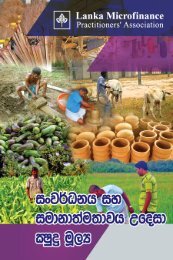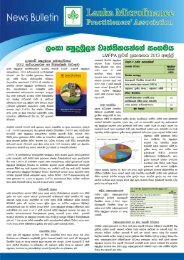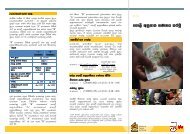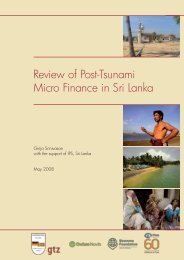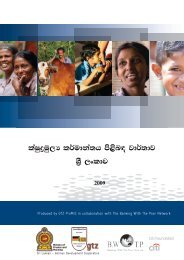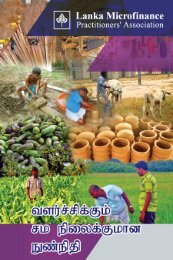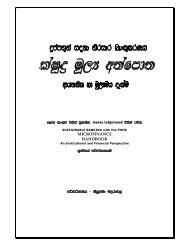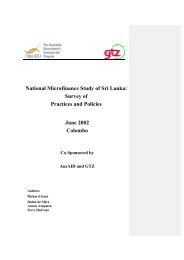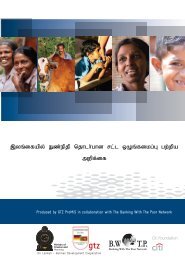Contents - Microfinance in Sri Lanka
Contents - Microfinance in Sri Lanka
Contents - Microfinance in Sri Lanka
You also want an ePaper? Increase the reach of your titles
YUMPU automatically turns print PDFs into web optimized ePapers that Google loves.
7.2.5 Micro F<strong>in</strong>ance<br />
7.2.5.1 The Exist<strong>in</strong>g Situation<br />
<strong>Microf<strong>in</strong>ance</strong> <strong>in</strong> <strong>Sri</strong> <strong>Lanka</strong> has a long tradition. It has been regarded as an effective <strong>in</strong>strument for<br />
reduction of poverty through the creation of jobs for the poor and restoration of their livelihood. At<br />
present, microf<strong>in</strong>ance is practiced by many actors that range from m<strong>in</strong>istries to commercial banks,<br />
specialized banks, registerd f<strong>in</strong>ance company and <strong>in</strong>formal lenders. Many donors and NGOs also support<br />
to improve the accessibility of poor people to f<strong>in</strong>ancial services. The government of <strong>Sri</strong> <strong>Lanka</strong> is the<br />
major provider of f<strong>in</strong>ancial services through various agencies. About 65 percent of the total micro credit<br />
<strong>in</strong> the country is provided by the government.<br />
Accord<strong>in</strong>g to a survey conducted by the Consultative Group to Assist the Poorest (CGAP),<br />
microf<strong>in</strong>ance <strong>in</strong> <strong>Sri</strong> <strong>Lanka</strong> has achieved impressive outreach; with more than 15 million deposit accounts<br />
and 2 million outstand<strong>in</strong>g micro loans from a population of 20 million people. In addition to micro loans,<br />
work<strong>in</strong>g capital, trade f<strong>in</strong>ance, <strong>in</strong>vestment credit, crop loans and sav<strong>in</strong>gs facilities are the most common<br />
services provided. Notwithstand<strong>in</strong>g this achievement, several challenges h<strong>in</strong>der the development of an<br />
effective and susta<strong>in</strong>able microf<strong>in</strong>ance sector <strong>in</strong> the country.<br />
7.2.5.2 Issues and Challenges:<br />
At present a microf<strong>in</strong>ance policy is not found <strong>in</strong> the country. In consequence, there is no<br />
<strong>in</strong>stitutionalized mechanism to coord<strong>in</strong>ate the microf<strong>in</strong>ance <strong>in</strong>terventions with other policies, which have<br />
been formulated for rural development. In this environment the sector has been fragmented. Responsibilities<br />
<strong>in</strong> the sector are scattered among different agencies, which <strong>in</strong> part have quit different views of the role of<br />
the microf<strong>in</strong>ance sector <strong>in</strong> the development process of <strong>Sri</strong> <strong>Lanka</strong>.<br />
The supervisory and regulatory framework are found for commercial banks, specialized banks,<br />
f<strong>in</strong>ance companies and regional development banks with the Central Bank of <strong>Sri</strong> <strong>Lanka</strong> be<strong>in</strong>g the<br />
supervisory body. There is a very rough framework for Co-operative Rural Banks. However, no regulations<br />
are found for Micro F<strong>in</strong>ance Institutions (MFIs) and NGOs. The absence of a unique policy and<br />
supervisory framework has allowed the proliferation of fundamentally unsusta<strong>in</strong>able MFIs which weakens<br />
governance, dim<strong>in</strong>ishes the <strong>in</strong>stitutional autonomy, exacerbates the lack of enforcement of f<strong>in</strong>ancial<br />
prudence and does not provide for transformation of MFIs and NGOs <strong>in</strong>to depository <strong>in</strong>stitutions or<br />
regularize their sav<strong>in</strong>gs activities.<br />
The lack of <strong>in</strong>stitutions for specialized tra<strong>in</strong><strong>in</strong>g and research <strong>in</strong> microf<strong>in</strong>ance is a major issue. The<br />
tra<strong>in</strong><strong>in</strong>g programme conducted by certa<strong>in</strong> government agencies and NGOs do not meet the entire<br />
requirements of the sector. They do not offer a comprehensive curriculum that is consistent with<br />
microf<strong>in</strong>ance best practices, which is a requirement of the majority of MFIs. Some semiformal MFIs are<br />
unaware of their need for such tra<strong>in</strong><strong>in</strong>g. Further, the academic courses <strong>in</strong> microf<strong>in</strong>ance are not found <strong>in</strong><br />
universities. The dearth <strong>in</strong> tra<strong>in</strong><strong>in</strong>g and research activities has contributed to the fragile nature of the<br />
sector and weaknesses such as substandard portfolio management, low qualifications of the staff, shortage<br />
of clear bus<strong>in</strong>ess concepts, obsolete account<strong>in</strong>g standards and the rudimentary level of <strong>in</strong>formation<br />
technology.<br />
The f<strong>in</strong>ancial results of the majority of MFIs, have failed to conform to <strong>in</strong>ternationally accepted<br />
standard for susta<strong>in</strong>ability. Their f<strong>in</strong>ancial viability is deteriorat<strong>in</strong>g. Services offered do not sufficiently<br />
take <strong>in</strong>to account the needs of the target group. Supply as a whole is not differentiated enough and the<br />
terms of credit have a rather prohibitive effect on clients. The long – term credits are lack<strong>in</strong>g. Supply of<br />
f<strong>in</strong>ancial services also differs from region to region. The offers are deficient s<strong>in</strong>ce they are ma<strong>in</strong>ly used by<br />
non-poor or people close to the poverty l<strong>in</strong>e. The microf<strong>in</strong>ance f<strong>in</strong>ancial services system needs to have<br />
a broader outreach to the poor and very poor members of the population.<br />
128




